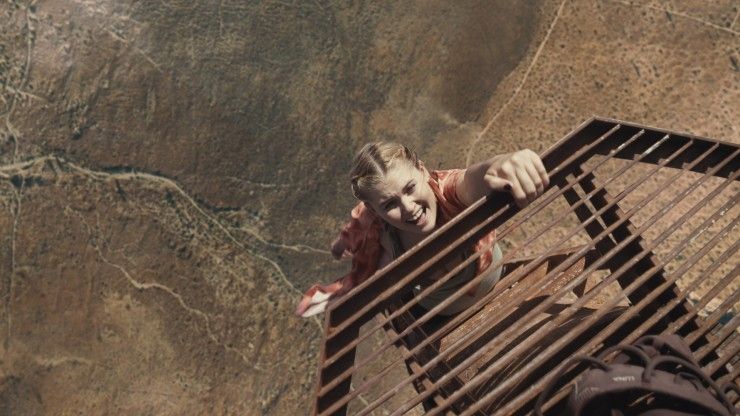
Move over, dubbing. "Vubbing" is all the rage now.
What do you do when you have to reshoot scenes but don’t have the budget? The filmmakers behind the indie action-thriller Fall were facing this issue when Lionsgate picked up the movie for a U.S. theatrical release and asked the filmmakers to tone down the number of F-bombs dropped in action scenes.
In a high-intensity action sequence, two friends are climbing an abandoned radio tower to scatter the ashes of Becky’s (Grace Caroline Currey) late husband. When a section of the rickety ladder breaks from the dilapidated tower, the two friends are left stranded.
During this scene, multiple curse words naturally slip out, perfectly capturing the peril of the situation. Unfortunately, that response is too much for the Motion Picture Association of America.
With a production budget of $3 million, the producers couldn’t afford to reshoot all the scenes where the petrified tower climbers screamed “fuck.” Variety reports that the crew’s solution was to turn to deepfake technology.
Scott Mann, who directed and co-wrote Fall, turned to his artificial-intelligence dubbing technology system, Flawless. To get the PG-13 rating the studio and crew wanted the film to have, the Flawless team was able to change more than 30 F-bombs throughout the film during post-production to more family-friendly words like “freaking.”
Founded in 2021, Flawless originally designed its TrueSync AI-based system to provide a better dubbing solution for films translated into other languages. TrueSync dubs by altering the mouth movements of the actors to match the alternate dialogue being spoken by employing the same principles used to create “deepfakes.”
The process is dubbed “vubbing.”
Mann realized that the Flawless engine could also be used to clean up dialogue from the films that were just shy of the PG-13 rating without breaking the production’s budget.
“For a movie like this, we can’t reshoot it,” Mann says about testing his AI on Fall in a behind-the-scenes video feature. “We’re not a big tentpole… we don’t have the resources, we don’t have the time, more than anything else. What really saved this movie and brought it into a wider audience was technology.”
Fall was shot in IMAX format in the Shadow Mountains in California's Mojave Desert. Reshooting the scene with F-bombs would have cost millions of dollars and taken several weeks. Mann and his Flawless team did the “neural reshoots” within two weeks during the final stages of post-production.
“When we were filming a movie, we didn’t know if we were R or if we were PG-13, so I said the F-word so many times I think Scott wanted to kill me in post when we were trying to get a PG-13 rating,” actor Virginia Gardener says.
It was important to Fall’s crew and Lionsgate that the film was rated PG-13. This rating would open up the theater doors to all who want family-friendly action scenes.

When rewatching the film, the actors couldn’t tell when the redubbing was happening. “As far as I know, every movement my mouth made in that movie, my mouth made,” said actor Grace Caroline Currey.
This new technology is huge for the films that are being dubbed in foreign languages, but it can also lead to some interesting and ethical concerns. We’ve seen Disney going back to its vault and re-editing films from years ago to meet Disney’s family-friend content expectations. We have also seen the problems that have come from deepfakes, but imagine what could change with vubbing becoming a staple tool in post-production.
For now, Mann’s invention is a great tool for filmmakers with a tight budget in post-production.
Let us know your thoughts in the comments below!
Your Comment